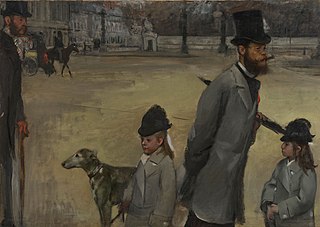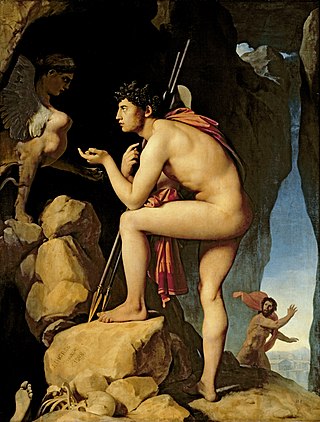
Édouard Manet was a French modernist painter. He was one of the first 19th-century artists to paint modern life, as well as a pivotal figure in the transition from Realism to Impressionism.

Impressionism was a 19th-century art movement characterized by relatively small, thin, yet visible brush strokes, open composition, emphasis on accurate depiction of light in its changing qualities, ordinary subject matter, unusual visual angles, and inclusion of movement as a crucial element of human perception and experience. Impressionism originated with a group of Paris-based artists whose independent exhibitions brought them to prominence during the 1870s and 1880s.

Mary Stevenson Cassatt was an American painter and printmaker. She was born in Allegheny, Pennsylvania, and lived much of her adult life in France, where she befriended Edgar Degas and exhibited with the Impressionists. Cassatt often created images of the social and private lives of women, with particular emphasis on the intimate bonds between mothers and children.

Edgar Degas was a French Impressionist artist famous for his pastel drawings and oil paintings.

Jacques Joseph Tissot, better known as James Tissot, was a French painter, illustrator, and caricaturist. He was born to a drapery merchant and a milliner and decided to pursue a career in art at a young age, coming to incorporate elements of realism, early Impressionism, and academic art into his work. He is best known for a variety of genre paintings of contemporary European high society produced during the peak of his career, which focused on the people and women's fashion of the Belle Époque and Victorian England, but he would also explore many medieval, biblical, and Japoniste subjects throughout his life. His career included work as a caricaturist for Vanity Fair under the pseudonym of Coïdé.

The Courtauld Gallery is an art museum in Somerset House, on the Strand in central London. It houses the collection of The Samuel Courtauld Trust and operates as an integral part of The Courtauld Institute of Art.

Japonisme is a French term that refers to the popularity and influence of Japanese art and design among a number of Western European artists in the nineteenth century following the forced reopening of foreign trade with Japan in 1858. Japonisme was first described by French art critic and collector Philippe Burty in 1872.

Place de la Concorde or Viscount Lepic and his Daughters Crossing the Place de la Concorde is an 1875 oil painting by Edgar Degas. It depicts the cigar-smoking Ludovic-Napoléon Lepic, his daughters Eylau and Jeanine, his dog, and a solitary man on the left at Place de la Concorde in Paris. The man on the left may be the playwright Ludovic Halévy. The Tuileries Gardens can be seen in the background, behind a stone wall.

Les Choristes is an 1877 pastel on monotype by French artist Edgar Degas. Part of a series of similar works depicting daily public entertainment at the time, it shows a group of singers performing a scene from the opera Don Giovanni, the only work by Degas depicting an operatic performance without dancers.

The Child's Bath is an 1893 oil painting by American artist Mary Cassatt. The painting continues her interest in depicting bathing and motherhood, but it is distinct in its angle of vision. Both the subject matter and the overhead perspective were inspired by Japanese Woodcut prints and Edgar Degas.

A Cotton Office in New Orleans, also known as Interior of an Office of Cotton Buyers in New Orleans and Portraits in an Office (New Orleans), is an oil painting by Edgar Degas. Degas depicts the interior of his maternal uncle Michel Musson's cotton firm in New Orleans. Musson, Degas's brothers René and Achille, Musson's son-in-law William Bell, and other associates of Musson are shown engaged in various business and leisure activities while raw cotton rests on a table in the middle of the office.

Interior, also known as The Rape, is an oil painting on canvas by Edgar Degas (1834–1917), painted in 1868–1869. Described as "the most puzzling of Degas's major works", it depicts a tense confrontation by lamplight between a man and a partially undressed woman. The theatrical character of the scene has led art historians to seek a literary source for the composition, but none of the sources proposed has met with universal acceptance. Even the painting's title is uncertain; acquaintances of the artist referred to it either as Le Viol or Intérieur, and it was under the latter title that Degas exhibited it for the first time in 1905. The painting is housed in the Philadelphia Museum of Art.

Plum Brandy, also known as The Plum, is an oil painting by Édouard Manet. It is undated but thought to have been painted about 1877. The painting measures 73.6 centimetres (29.0 in) by 50.2 centimetres (19.8 in). It depicts a woman seated alone at a table in a cafe, in a lethargic pose similar to that of the woman in Degas' L'Absinthe. The woman may be a prostitute, but unlike the subject of Degas' work she appears more dreamy than depressed. She holds an unlit cigarette and her plum soaked in brandy appears untouched.

Still Life with Profile of Laval is an 1886 oil painting by French artist Paul Gauguin, located in the Indianapolis Museum of Art, which is in Indianapolis, Indiana. It depicts Gauguin's friend Charles Laval in profile with an assortment of inanimate objects, including a ceramic pot Gauguin made himself.

Oedipus and the Sphinx is a painting by the French Neoclassical artist Jean-Auguste-Dominique Ingres. Originally a student work painted in 1808, it was enlarged and completed in 1827. The painting depicts Oedipus explaining the riddle of the Sphinx. An oil painting on canvas, it measures 189 x 144 cm, and is in the Louvre, which acquired it in 1878.

Mother and Child (The Oval Mirror) is an oil-on-canvas painting by Mary Cassatt. The painting depicts a mother and her child in front of a mirror. The painting provides a glimpse of the domestic life of a mother and her child, evoking religious iconography from the Italian Renaissance. However, portrayals of a mother and her child are common in Cassatt's work, so it is possible that this similarity is coincidental rather than intentional.
Prostitution in Impressionist painting was a common subject in the art of the period. Prostitution was a very widespread phenomenon in nineteenth-century Paris and although an accepted practice among the nineteenth century bourgeoisie, it was nevertheless a topic that remained largely taboo in polite society. As a result, Impressionist works depicting the prostitute often became the subject of scandal, and particularly venomous criticism. Some works showed her with considerable sympathy, while others attempted to impart an agency to her; likewise some work showed high-class courtesans, and others prostitutes awaiting clients on the streets. In addition to the sexual revulsion/attraction the figure of the prostitute stirred, she functioned as a sign of modernity, a clear sign of the entanglement of sex, class, power and money.

Singer with a Glove by Edgar Degas, originally titled Chanteuse de Café, la chanteuse au gant, is an 1878 pastel drawing on canvas 53.2 x 41 cm. Degas was a French artist known for his pastels, paintings, sculptures, prints, and charcoal drawings. This pastel is part of a series of works that have cafe-concert singers as their subject. Degas was a habitué of those places, especially the Cafe des Ambassadeurs, and he uses them as the settings for many of his works.

Amédée-David, the Comte de Pastoret (1823-1826) is a portrait by French painter Jean-Auguste-Dominique Ingres. The oil on canvas painting depicts Count Amédée-David de Pastoret at 32 years old, wearing a medal of the Order of the Legion of Honor.

At the Races in the Countryside or Carriage at the Races is an 1869 oil painting by the French painter Edgar Degas. The painting, which depicts a scene of a family in a horse-drawn carriage in the countryside, is on display at the Museum of Fine Arts Boston. The painting was shown at the First Impressionist Exhibition in 1874.



















